Waking up with a stiff neck or feeling that sharp pinch every time you turn your head isn’t just annoying; it can be downright debilitating. Neck nerve pain, sometimes feeling like a cruel companion that just won’t let go, can greatly affect one’s daily life, from work to recreation. Yet, amidst this discomfort, there’s hope. If you’re tired of being held back by that persistent ache, you’ve landed in the right place. Dive in as we unravel the causes of neck nerve pain and, more importantly, shed light on effective treatments and home remedies that can serve as your roadmap to relief.
Contents
Understanding Neck Nerve Pain
 Your neck, more technically referred to as the cervical spine, is a delicate marvel of engineering. Comprised of seven bones stacked atop one another, this structure is responsible for supporting your head, which weighs roughly the same as a bowling ball. Interspersed between these bones are cervical discs that act as cushions. Alongside these, a network of nerves emerges, branching out to relay messages between your brain and various parts of your body.
Your neck, more technically referred to as the cervical spine, is a delicate marvel of engineering. Comprised of seven bones stacked atop one another, this structure is responsible for supporting your head, which weighs roughly the same as a bowling ball. Interspersed between these bones are cervical discs that act as cushions. Alongside these, a network of nerves emerges, branching out to relay messages between your brain and various parts of your body.
But what happens when this sophisticated system goes awry? They can manifest as:
- Sharp shooting pains in the neck or radiating down the arms.
- Numbness or tingling in the shoulders, arms, or fingers.
- Muscle weakness or difficulty gripping objects.
- A burning sensation or heightened sensitivity in the affected area.
Recognizing these signs is the first step in the journey toward relief. The good news? Many interventions, from simple exercises to medical treatments, can help alleviate and manage this discomfort. Let’s delve deeper into the solutions that await.
What Causes a Pinched Nerve in the Neck?
 A pinched nerve, scientifically termed cervical radiculopathy, is when a nerve in the neck is compressed or irritated, giving rise to a range of symptoms. But what exactly leads to this pinching? Here’s a closer look at the culprits:
A pinched nerve, scientifically termed cervical radiculopathy, is when a nerve in the neck is compressed or irritated, giving rise to a range of symptoms. But what exactly leads to this pinching? Here’s a closer look at the culprits:
- Bad Posture: In today’s digital age, slouching over phones and computers has become second nature. Over time, maintaining this forward head posture can place excessive strain on the neck, leading to nerve compression. Remember, for every inch your head leans forward, an additional 10 pounds of weight is felt by your neck!
- Herniated Discs: As mentioned earlier, the cervical discs act as cushions between the bones of the spine. Due to various reasons such as wear and tear, or sudden strain, these discs can rupture. When that happens, the soft center can protrude out and press against the nearby nerve.
- Osteoarthritis: This is a degenerative joint condition that affects millions. As cartilage wears away with age, bones begin to rub against each other. This friction can result in the formation of bone spurs, which can encroach upon the space designated for nerves.
- Trauma or Injuries: Sudden impacts, like those from car accidents or sports-related collisions, can cause immediate damage to the neck. This trauma can displace spinal bones or cause swelling, which might impinge on a nerve.
- Spinal Stenosis: This involves the narrowing of spaces within the spine, which can put pressure on the nerves. It’s typically due to wear-and-tear changes that occur with age.
- Tumors or Growths: In rare cases, growths or benign tumors in the cervical spine can press on the nerves, leading to pain and discomfort.
- Other Factors: Conditions like rheumatoid arthritis, thyroid disease, or diabetes can influence nerve sensitivity and function, potentially leading to cervical radiculopathy.
Understanding the root cause of your pinched nerve is crucial, as it not only dictates the treatment approach but also informs preventive measures. If you suspect you might have a pinched nerve, it’s essential to seek medical advice for a proper diagnosis and effective management.
Immediate Relief Measures for Acute Pain

The searing sensation of a pinched nerve in your neck can strike suddenly and intensely. During these acute moments, you might feel an overwhelming desire to alleviate the pain swiftly. While it’s essential to seek medical advice for persistent symptoms, there are several non-pharmaceutical interventions you can employ for immediate relief:
Maintain Proper Neck Posture
Keep your neck aligned with the spine. When sitting, ensure your feet are flat on the ground, and your computer or reading material is at eye level. This minimizes undue strain on the neck muscles and nerves.
Cold Packs
Applying a cold pack can numb the sore area and reduce inflammation. Ensure the cold pack is wrapped in a thin cloth or towel to prevent frostbite. Hold it against the painful spot for 15-20 minutes, then give your skin a break for at least an hour before reapplying.
Warm Compress
If you don’t notice any swelling, a warm compress can help relax and loosen tissues and stimulate blood flow to the area. Just like with the cold pack, ensure the heat is not too intense, and avoid direct contact with the skin.
Gentle Neck Stretches
Gentle stretching can relieve pressure on the pinched nerve. Remember to keep movements slow and controlled. If any stretch exacerbates the pain, stop immediately.
Neutral Position Sleeping
Sleep with your head and neck aligned with your body, as if you’re standing up. This might mean adjusting your pillow or opting for a specialized orthopedic one.
Limit Physical Activity
If a particular activity aggravates the pain, it’s wise to take a break from it. Avoid lifting heavy items and strenuous neck movements.
Over-the-Counter Pain Relievers
While the focus here is on non-pharmaceutical measures, it’s worth noting that non-prescription pain relievers can offer temporary relief. However, they should be used judiciously and always according to the label or a physician’s advice.
Mindfulness and Breathing Exercises
Sometimes, calming the mind can have a pronounced effect on physical discomfort. Deep breathing and mindfulness meditation can help divert attention from pain and foster relaxation.
Remember, these are initial relief measures. If pain persists or if you’re uncertain about its origin, it’s imperative to consult a healthcare professional to ensure there aren’t more serious underlying causes.
Exercises to Alleviate and Prevent Neck Nerve Pain
Exercising the neck and surrounding muscles can be a potent tool against nerve pain. The right exercises can enhance mobility, strength, and flexibility, ultimately reducing the likelihood of nerve compression. Here’s a set of exercises to help you on your journey to a pain-free neck:
Neck Tilts
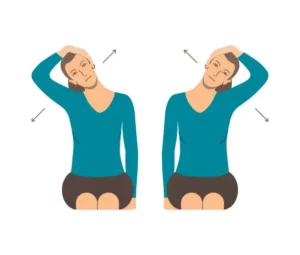
- How: Sit or stand straight. Slowly tilt your head to one side, aiming to touch your ear to your shoulder (without raising the shoulder).
- Benefits: This stretches the side muscles of your neck and helps improve lateral flexibility.
Neck Turns
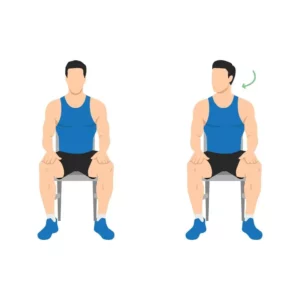
- How: Rotate your head slowly to one side until your chin aligns with your shoulder. Hold, then return to the center and repeat on the other side.
- Benefits: Enhances neck’s rotational mobility and eases stiffness.
Shoulder Rolls

- How: Roll your shoulders backward in a circular motion, then switch and roll them forward.
- Benefits: Relieves tension in the shoulders, which can contribute to neck pain.
Neck Flexion and Extension

- How: Sit tall and look forward. Gently lower your head, aiming to touch your chin to your chest. Then slowly tilt your head back and look up to the ceiling.
- Benefits: Stretches both the front and back neck muscles, fostering a full range of motion.
Wall Push-ups

- How: Stand arms-length from a wall, place your palms flat against it. Bend your elbows and bring your body towards the wall, then push back to the starting position.
- Benefits: Strengthens the upper body without adding strain to the neck.
Isometric Neck Exercises
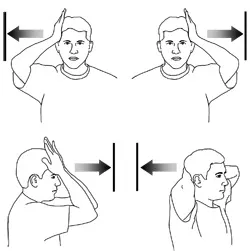
- How: Place your hand against your forehead. Push your forehead into your hand without letting your head move forward. Repeat the pressure from the sides and the back.
- Benefits: Strengthens neck muscles without needing to move the neck – particularly useful if motion causes pain.
Scapula Squeeze
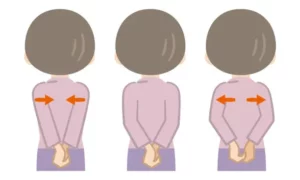
- How: While sitting or standing straight, squeeze your shoulder blades together as if you’re trying to hold a pencil between them.
- Benefits: Strengthens the upper back and realigns posture to reduce neck strain.
Chin Tucks
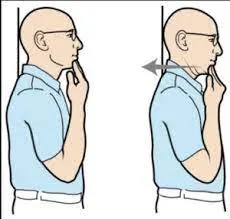
- How: Sit or stand up straight. Gently tuck your chin down towards your neck, creating a “double chin.”
- Benefits: Strengthens the muscles that align the back of the head with the spine.
Consistency is key with these exercises. Doing them regularly will maximize benefits.
When to Seek Medical Intervention
Neck nerve pain, while often manageable with self-care and exercises, can sometimes be indicative of a more serious underlying condition. It’s essential to recognize the signs that necessitate a visit to a medical professional:
- Persistent pain that doesn’t improve after several weeks of self-care.
- Pain that radiates down arms or legs.
- Weakness, numbness, or tingling in the arms or hands.
- Difficulty gripping objects or lifting them.
- Pain that’s worsened at night or disrupts sleep.
- Any accompanying symptoms like headaches, dizziness, or loss of balance.
If any of these symptoms present, it’s essential to consult a healthcare professional for a precise diagnosis and tailored treatment plan.
Alternative Therapies for Neck Nerve Pain
 Venturing beyond conventional medical treatments, there are several alternative therapies that many individuals have found effective for neck nerve pain:
Venturing beyond conventional medical treatments, there are several alternative therapies that many individuals have found effective for neck nerve pain:
- Physical Therapy: Led by professional physical therapists, these sessions focus on specific exercises, stretches, and techniques to strengthen and improve the neck’s mobility. The goal is often to alleviate pain and prevent future episodes.
- Acupuncture: This ancient Chinese medicine technique involves inserting thin needles at specific points on the body. It’s believed to redirect the body’s energy and reduce pain.
- Chiropractic Adjustments: Chiropractors use hands-on spinal manipulations to realign the body’s musculoskeletal structure. These adjustments can help restore mobility to joints restricted by tissue injury.
- Massage Therapy: Focusing on manipulating soft tissues, massage can help reduce muscle tension, enhance circulation, and promote relaxation, which can be particularly effective for muscular-related neck pain.
- Heat and Cold Therapies: Alternating between heat and cold can reduce inflammation, enhance blood flow, and relieve pain. Cold narrows blood vessels and reduces blood flow, reducing inflammation, while heat relaxes and loosens tissues and stimulates blood flow to the area.
- TENS (Transcutaneous Electrical Nerve Stimulation): A battery-powered device sends small electrical pulses along nerve strands, which is believed to interfere with pain signals being sent to the brain and may stimulate the production of endorphins, the body’s natural painkillers.
Each therapy has its unique approach, and while many individuals find relief through them, it’s crucial to remember that results can vary.
Conclusion
Neck nerve pain can be a daunting experience, impacting daily routines and overall well-being. While there are numerous self-help measures and alternative therapies to consider, understanding when to seek professional guidance is paramount. It’s about creating a balance between self-management and getting the right expert intervention. If you’re grappling with persistent neck discomfort, remember: you’re not alone, and professional help is at hand. If you’re experiencing Neck pain, physical therapy for neck pain at PhysioMantra can help: Book an online physical therapy session.



